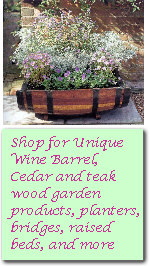With cut flowers available year-round from florists, why would
anyone want to grow their own? There are many reasons once you think about it.
First, consider cost. The price of a few packets of seeds and
a little water, fertilizer, and sometimes pesticide is the only monetary outlay
for gardeners. Even if you add the value of your labor, the resulting cost is a
savings over store-bought bouquets.
Second, think about availability. For one reason or another,
not all varieties of flowers that do well as cut specimens can be found in local
flower shops. Your selection of blossoms for arrangements can be increased
tremendously by growing your own.
Third, you just can't get a fresher product than a flower cut
from your own backyard. If conditioned correctly, the flowers you grow for
yourself have the potential of lasting much longer than those supplied by a
florist.
Lastly, by growing cut flowers, you have the opportunity to
design arrangements without the constraints of high cost or limited
availability. You can use leaves from landscape plants for foliage to fill in
arrangements. By combining home-grown varieties with exotics from a flower shop,
you can come up with unlimited possibilities.
To grow your own cut flowers, start with a good location for
the flower bed. You need good garden soil and a minimum of six hours sunlight.
Since you plan to cut these flowers when they reach peak quality, you don't want
the bed in public view. A section of your vegetable garden may be ideal.
Start with seed catalogs, choosing varieties of flowers you
like. Vary sizes, shapes, and colors. Be sure to choose flowers for all seasons.
Check the All American Selections noted as good cut flowers.
Annuals for cut flowers are often referred to as
cut-and-come-again because they will rebloom if cut during the growing season.
They provide many flowers over a long time at a low cost, but annuals must be
replanted yearly.
Perennials have a higher initial cost than annuals, but they
usually increase in plant size and number of blooms each year. Compared to
annuals, they usually have a shorter bloom time, but with careful selection you
can choose perennials with long, blooming periods.
If you choose to purchase seed for growing cut flowers, the
selection is almost limitless. Generally, you can save money by purchasing seed,
but the plants take longer to flower.
When you buy transplants, you are limited to the grower's
choices, many of which may make better landscape plants than cut flowers. The
plants also are higher in cost, but they flower sooner than those grown from
seed.
Some of the most common flowers that make good cut flowers are
rose, peony, chrysanthemum, daisy, marigold, geranium, iris, gladiolus,
delphinium, and zinnia. Spring-flowering bulbs, such as tulip and daffodil,
should not be overlooked.
In late winter, don't forget to force branches of flowering
trees and shrubs to extend the season of cut flowers from your yard. In autumn,
try brightly colored leaves and dried grasses as late-season extenders.
![]() Gardeners' Corner
Kids'
Garden
Sustainable Garden
Contact Us
Gardeners' Corner
Kids'
Garden
Sustainable Garden
Contact Us![]()

